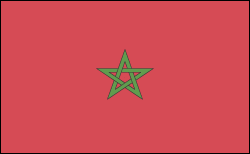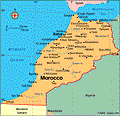Morocco | Facts & Information

- Morocco Profile
- History
- News and Current Events
Infoplease has everything you need to know about Morocco. Check out our country profile, full of essential information about Morocco's geography, history, government, economy, population, culture, religion and languages. If that's not enough, click over to our collection of world maps and flags.
Facts & Figures
-
Ruler: King Muhammed VI (1999)
Prime Minister: Aziz Akhannouch (2021)
Land area: 276,564 sq mi (716,300 sq km); total area: 276,661 sq mi (716,550 sq km)
Population (2022 est. and includes Western Sahara): 36,738,229 (growth rate: .91%); birth rate: 17.42/1000; infant mortality rate: 19.2/1000; life expectancy: 73.68; density per sq km: 76
Capital (2017 est.): Rabat, 1,932,000
Largest cities: Casablanca, 3,840,000; Fez, 1,267,000; Marrakech, 1,033,000
Monetary unit: Dirham
National name: al-Mamlaka al-Maghrebia
Languages: Arabic (official), Berber dialects, French often used for business, government, and diplomacy
Ethnicity/race: Arab-Berber 99%, Other 1%
Religions: Muslim 99% (official; virtually all Sunni, <0.1% Shia), other 1% (includes Christian, Jewish, and Baha'i); note - Jewish about 3,000-3,500 (2020 est.)
National Holiday: Throne Day, July 30
Literacy rate: 73.8% (2018 est.)
Economic summary: GDP/PPP (2020 est.): $259.42 billion; per capita $6,900. Real growth rate: 2.5%. Inflation: .2%. Unemployment: 9.23%. Arable land: 17.5%. Agriculture: barley, wheat, citrus, wine, vegetables, olives; livestock. Labor force: 10.399 million; agriculture 39.1%, services 40.5%, industry 20.3% (2014 est.). Industries: phosphate rock mining and processing, food processing, leather goods, textiles, construction, tourism. Natural resources: phosphates, iron ore, manganese, lead, zinc, fish, salt. Exports: $37.52 billion (2020 est.): clothing, fish, inorganic chemicals, transistors, crude minerals, fertilizers (including phosphates), petroleum products, fruits, vegetables. Imports: $46.26 billion (2020 est.): crude petroleum, textile fabric, telecommunications equipment, wheat, gas and electricity, transistors, plastics. Major trading partners: France, Spain, UK, Italy, India, Germany, Russia, Saudi Arabia, China (2020).
Communications: Telephones: main lines in use: 2,357,286 (2020); mobile cellular: 49,421,023 (2020). Radio broadcast stations: AM 27, FM 25, shortwave 6 (2020). Radios: 6.64 million (1997). Television broadcast stations: 35 (plus 66 repeaters) (1995). Televisions: 3.1 million (1997). Internet Service Providers (ISPs): 2,102,434 (2020). Internet users: 31,004,869 (2020).
Transportation: Railways: total: 2,067 km (2014). Highways: total: 57,300 km; paved: 32,716 km (includes 507 km of expressways); unpaved: 24,777 km (2020). Ports and harbors: Agadir, El Jadida, Casablanca, El Jorf Lasfar, Kenitra, Mohammedia, Nador, Rabat, Safi, Tangier; also Spanish-controlled Ceuta and Melilla. Airports: 62 (2021).
International disputes: claims and administers Western Sahara, but sovereignty remains unresolved - UN-administered cease-fire has remained in effect since September 1991, but attempts to hold a referendum have failed and parties thus far have rejected other proposals; Morocco protests Spain's control over the coastal enclaves of Ceuta, Melilla, and Penon de Velez de la Gomera, the islands of Penon de Alhucemas and Islas Chafarinas, and surrounding waters; Morocco also rejected Spain's unilateral designation of a median line from the Canary Islands in 2002 to set limits to undersea resource exploration and refugee interdiction; Morocco allowed Spanish fishermen to fish temporarily off the coast of Western Sahara after an oil spill soiled Spanish fishing grounds.









